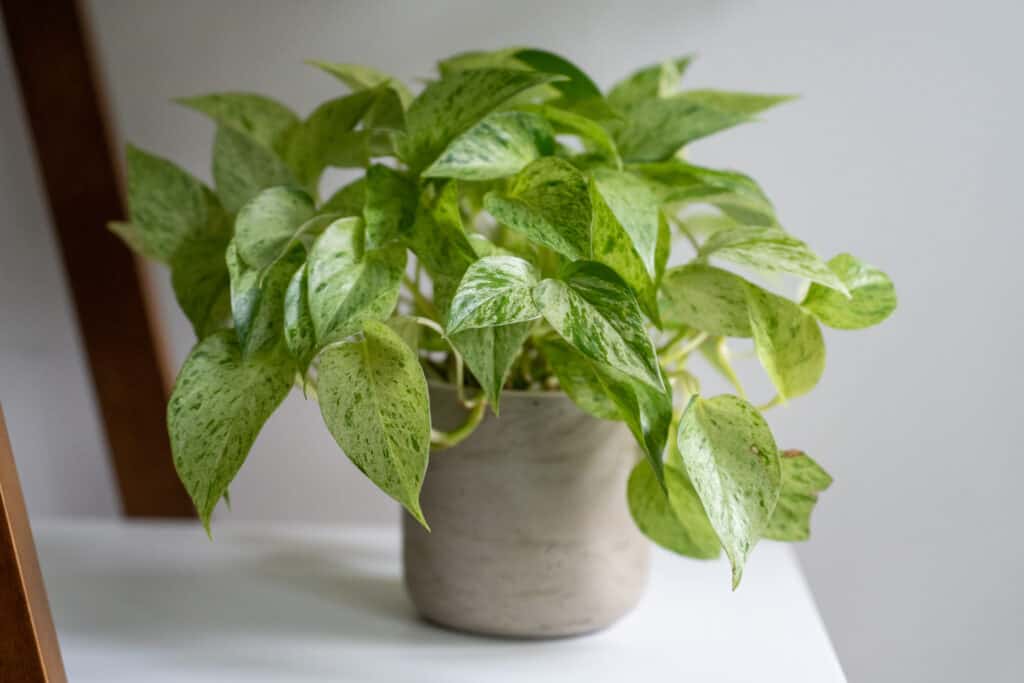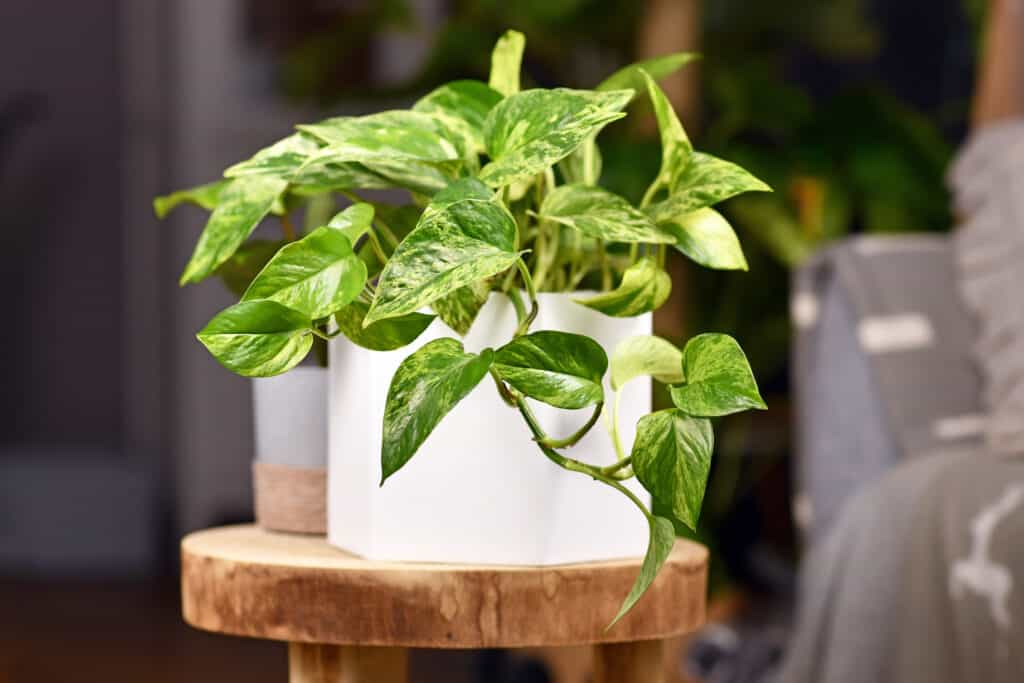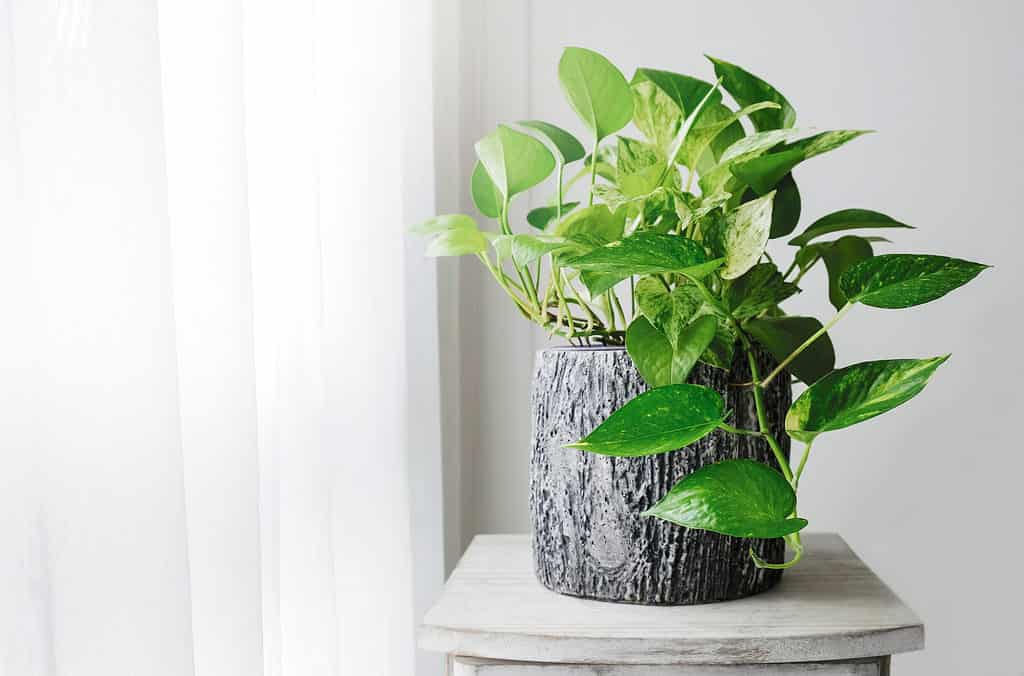If you’re a fan of houseplants, you’re likely familiar with the low-maintenance vining houseplant pothos. This plant becomes quite large in the wild, so you may wonder what size to expect from an indoor-grown version of pothos.
This article will cover pothos in general and discuss the size and growing habit differences between outdoor and indoor pothos.
So, without further ado, let’s jump in!
What is Pothos?

Pothos produce flowers in mature adult stages but rarely indoors.
©iStock.com/Jenny Sun
Native to the Solomon Islands of the South Pacific, pothos is a climbing vine that thrives in hot, humid environments. Belonging to arum plants in the Araceae family, pothos’ scientific name is Epipremnum aureum. This plant can grow up to 65 feet long in the wild with three-foot-long and wide variegated leaves. Common names for Epipremnum aureum include golden pothos, Solomon island’s ivy, hunter’s robe, and devil’s ivy. While the common names of this plant often include “ivy,” pothos doesn’t actually belong to the Hedera genus that includes ivies.
Originating in the Solomon Islands, this plant has become naturalized in tropical regions worldwide. Since the 1950s, horticulturists have created dozens of pothos cultivars that display a range of leaf variegation, colors, and shapes. This plant is hugely popular for its lovely vines, resiliency, and beginner-friendly growing requirements.
Why Does Pothos Grow So Big Outdoors?

A Giant jade pothos plant grows wild and climbs around a large tree’s trunk.
©iStock.com/Suprabhat Dutta
So, if you grow pothos indoors, will they grow to their massive outdoor length? Will they wrap their lovely tendrils around your home? Well, not quite. See, pothos grows to this incredible size outdoors because it can enter maturity. This plant only reaches the mature reproductive phase after it reaches at least 10 of age.
Pothos can enter maturity when grown outside or in the wild for a few reasons:
- Its roots have the space it needs to expand and grow large
- As it climbs higher on a tree, the vine receives more indirect sunlight, gaining the nutrients needed for larger leaves
- It lives much longer as an outdoor aroid perennial plant and grows larger yearly.
How Big Does Pothos Grow Indoors?

The Golden Pothos thrives in humid environments.
©iStock.com/Firn
Alright, we know pothos can grow to massive lengths in the wild, but just how big will this vine grow as a houseplant? You can expect pothos to grow up to 10 feet long, with many plants staying between 5-8 feet long. Ultimately, the length will depend on the cultivar and what conditions you grow the plant in. Rather than growing enormous, deeply split, variegated leaves, houseplant pothos will grow leaves ranging from 3-6 inches long, with entire margins.
Why does pothos only grow a fraction of its size indoors? As a houseplant, pothos remains in its juvenile phase for its entire life cycle. As such, it does not enter its reproductive phase, which, in combination with the conditions we described above, triggers increasing growth.
How to Support Optimal Growth in Houseplant Pothos

Houseplant pothos will grow leaves ranging from 3-6 inches long.
©ArtBackground/Shutterstock.com
As mentioned earlier, while pothos is famously low maintenance, it does require ideal conditions to grow to its maximum size indoors. As a tropical plant that grows in the understory of large trees, these conditions are:
- Bright, indirect sunlight
- Temperatures between 70-90 degrees F, especially in its growing seasons
- Humidity levels of 55-70%.
- Well-draining, aerated, slightly acidic (6.0-6.5 pH) soil or potting medium
- Water only when the top 2-3 inches of the soil are completely dry
- Enough room in its pot for root growth
- Added nutrients via an appropriate liquid fertilizer about once a month
So, while your pothos houseplant can easily survive conditions outside its ideal requirements, it will likely not grow to its fullest.
Why Isn’t My Pothos Houseplant Growing?
There are several reasons why your indoor pothos may not be growing as readily as you’d like. Under ideal circumstances, your pothos should grow 10-18 inches per month during its growing seasons (Spring-mid Summer).
This rate does depend on the cultivar of pothos that you’re growing. Essentially, the greener the leaves, the more chlorophyll the plant contains, and the faster it can grow. So pothos cultivars with white variegation of the leaves, like ‘Marble Queen,’ will grow slower due to containing less chlorophyll.
So if you’re not noticing the growth you expect from your cultivar, you likely need to change one or more aspects if it’s growing conditions. Reasons for stunted growth include:
- Not enough sunlight
- Dehydration
- Lack of oxygen to the roots
- Lack of root space in the pot
- Lack of nutrients
To fix this, make sure you’re providing the ideal conditions listed further up in the article. As you fix the problems stunting your pothos, you’ll typically see signs of new growth (new leaves) within a few weeks.
Up Next:
- How Big Are Monstera Houseplants
- Discover the Best Black Houseplants for Your Elegant Home
- Philodendron Cordatum vs. Heartleaf
The photo featured at the top of this post is © Christina Siow/Shutterstock.com
Sources
- A-Z Animals, Available here: https://a-z-animals.com/blog/algerian-ivy-vs-english-ivy-whats-the-difference/
- Wisconsin Horticulture, Available here: https://hort.extension.wisc.edu/articles/pothos-epipremmum-aureum/#:~:text=Pothos%2C%20also%20sometimes%20called%20devil's,aureum.
- Brazilian Journal of Botany (1970)
Thank you for reading! Have some feedback for us? Contact the AZ Animals editorial team.






